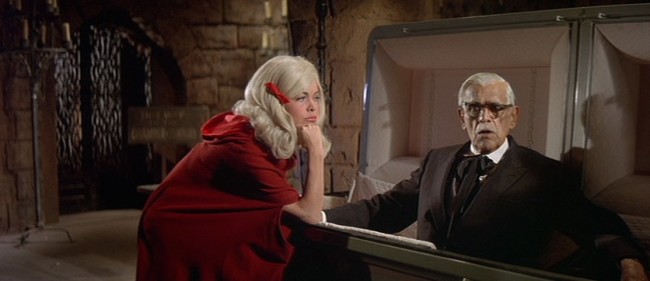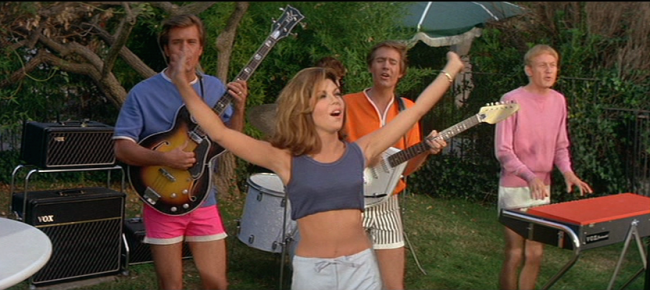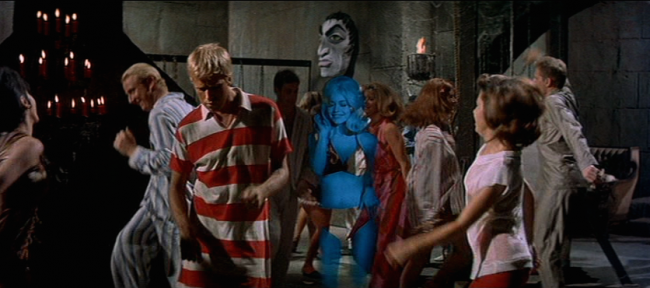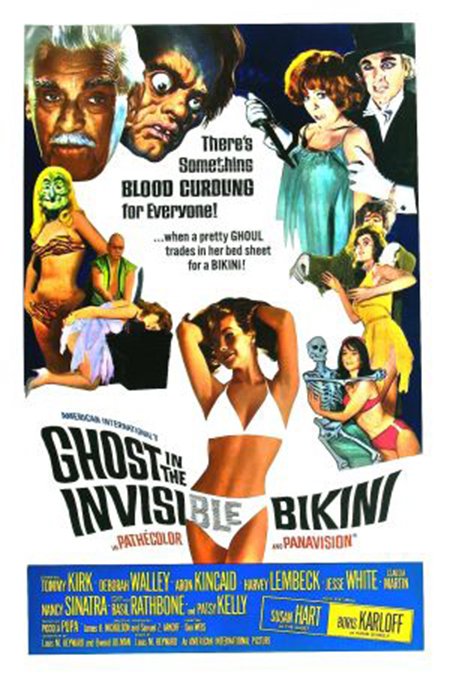(Editor’s Note: Oowee, got in just under the wire with this one. Thanks to Ruth of Silver Screenings and Kristina of Speakeasy for a neat excuse to write about one of my all-time guiltiest pleasures.)
Oh man, it’s literally the eleventh hour for posting a review Speakeasy/Silver Screenings’ 2015 Beach Party Blogathon, so here goes…
The Ghostess with the Mostest…
Released in April of 1966, on the tail end of American International Pictures’ (AIP) beach party film chronology, The Ghost in the Invisible Bikini (GitIB) stands as my favorite in the series.
What makes GitIB so much fun is its kitchen sink nature. It feels like there was a tacit acknowledgement that the “endless summer” of the surfin’ 60’s might actually be waning after all and a pull out all the stops attempt to buoy this baby was required. It shares a “more is better” affinity with the latter Universal Pictures monster rallies of House of Frankenstein and House of Dracula.

Couched in the – even then – hackneyed trappings of the “Old Dark House,” The Ghost in the Invisible Bikini could pass for a live Scooby Doo episode. It also greatly resembles the previous generation’s Kay Kyser vehicle You’ll Find Out, (1940) even sharing Boris Karloff as a cast member. The one twist in the script is that the villains have no idea they are being thwarted by real ghosts. Those ghosts are portrayed by Susan Hart, as Cecily, the titular see-thru character, and Karloff as former carnival owner Hiram Stokely, her surprised to find himself deceased beau.

The rest of the large GitIB cast is run through a series of the oldest story and sight gags in theatrical history. There’s an inheritance at stake, a multitude of revolving walls, secret passages and falling chandeliers, portraits that watch you, an escaped carnival gorilla, damsel in distress on a buzz saw, a grand guignol waxworks, and a string of Mack Sennet style chases. Fans of Roger Corman‘s Edgar Allan Poe films can have a heyday perusing this movie’s mis en scene. To my eye Stokley’s chamber of horrors was also the set of many an AIP EAP romp. Can anyone help out with specifics here?
Original series leads Frankie Avalon and Annette Funicello are replaced by another post-Disney kid, Tommy Kirk, and Deborah Walley in the hero and heroine roles. Beach film stalwart Harvey Lembeck, does mega slapstick throughout, returning for his last ride as motorcycle gang leader Eric Von Zipper.
Other cast members are a convergence of old and new Hollywood of the mid-1960’s. It’s an aspect the film shares with the contemporaneous Batman TV series, which premiered on ABC TV a few months earlier. Karloff, Basil Rathbone, Patsy Kelly, Jesse Young, and even Francis X. Bushman appear alongside the bevy of beach kids, with Rat Pack scion Nancy Sinatra and Claudia Martin representing a changing of the guard.

Sinatra offers a catchy pop tune “Geronimo,” backed by The Bobby Fuller Four. Fuller can be seen gyrating wildly through the instrumental “Swing A-Ma Thing” wielding an awesome Vox white teardrop guitar. The group serves as “house band” throughout the film. All songs are credited to series regulars Guy Hemric and Jerry Styner. The Les Baxter soundtrack is augmented by drip-drop reverb laden sound effects.

Historically Ghost in the Invisible Bikini represents a last innocent romp prior to the LSD exploitation and sensationalism of films like Riot On Sunset Strip, Pysch-Out and The Trip. Those films in turn presaged studio system killers like Five Easy Pieces and Easy Rider. Think of the cultural gap between The Monkees’ September 1966 pilot episode and their cinematic swansong Head and you’ll get my point.
I love the film because it incapsulates my late pre-teens with remembrances of the aforementioned Batman and Monkees TV series, The Munsters, Aurora plastic model monster kits, Famous Monsters of Filmland and Monster World magazines, Top 40 from a transistor radio speaker, The Beach Boys’ “Good Vibrations” on the AM airwaves, and begging my pop to take me to see Karloff in AIP’s Lovecraft adaptation Die Monster, Die.
